10 Best French Translation Apps (Free & Paid Options)

Whether you're traveling through Paris, collaborating with French-speaking colleagues, or creating multilingual content, having a reliable French translation app by your side makes life so much easier. It helps you understand, communicate, and express yourself naturally, without getting lost in translation.
In this blog, we'll list the 10 best French translation apps, highlighting what makes each one unique and how to choose the perfect fit for your needs. We'll also share actionable tips so you can use these apps to their fullest potential.
Let's get started.
Top French Translation Apps for Travel, Meetings & More
The table below gives you a quick overview of the best French translation apps available today. It focuses on each app's standout feature, language support, and pricing, helping you make the right decision.
| French Translation App | Standout Feature | Number of Supported Languages | Pricing |
| Maestra | Real-time voice translation | 125+ | Includes a 1-minute free trial; real-time translation plans start at $79 |
| Google Translate | All-in-one text, camera, and voice translation | 100+ | Free |
| DeepL | Highly accurate translations for professional use | 30+ | Free plan available; paid plans start at $8.74/month |
| Reverso Context | Contextual examples and learning tools | 18 | Free version; Premium from $6.49/month |
| Yandex Translate | Offline translator with camera and voice modes | 100+ | Free |
| Microsoft Translator | Multi-person live conversation mode for meetings | 100+ | Free (enterprise features via Microsoft 365) |
| iTranslate | Text, voice, and camera translation in a clean design | 100+ | Free version; PRO from $7.99/month |
| Naver Papago | Fast mobile translation | 14 | Free |
| Linguee | Bilingual dictionary with real-world usage examples | 25+ | Free |
| Vocre | Hands-free speech translation | 59 | Free version; PRO at $8.99 |
1. Maestra
Best for: real-time voice translation during meetings, events, and streams.
Maestra’s live voice translator makes real-time communication across languages simple. You just speak naturally in French (or any of 125+ supported languages). The tool instantly translates your voice into the target language, speaking it aloud with an AI voice or your cloned voice while showing matching captions on screen. For flexibility, Maestra also offers a caption-only option, where you can display real-time translations without any voice output.
Pros
- AI voice cloning for natural live translations
- Multilingual sessions (where you can translate French into multiple target languages at once)
- Integrations with Zoom, OBS, vMix, and Microsoft Teams
Cons
- Needs a stable internet connection
- Minor delay possible in sessions
Pricing: Includes a 1-minute free trial. Real-time translation plans start at $79. See more on pricing.
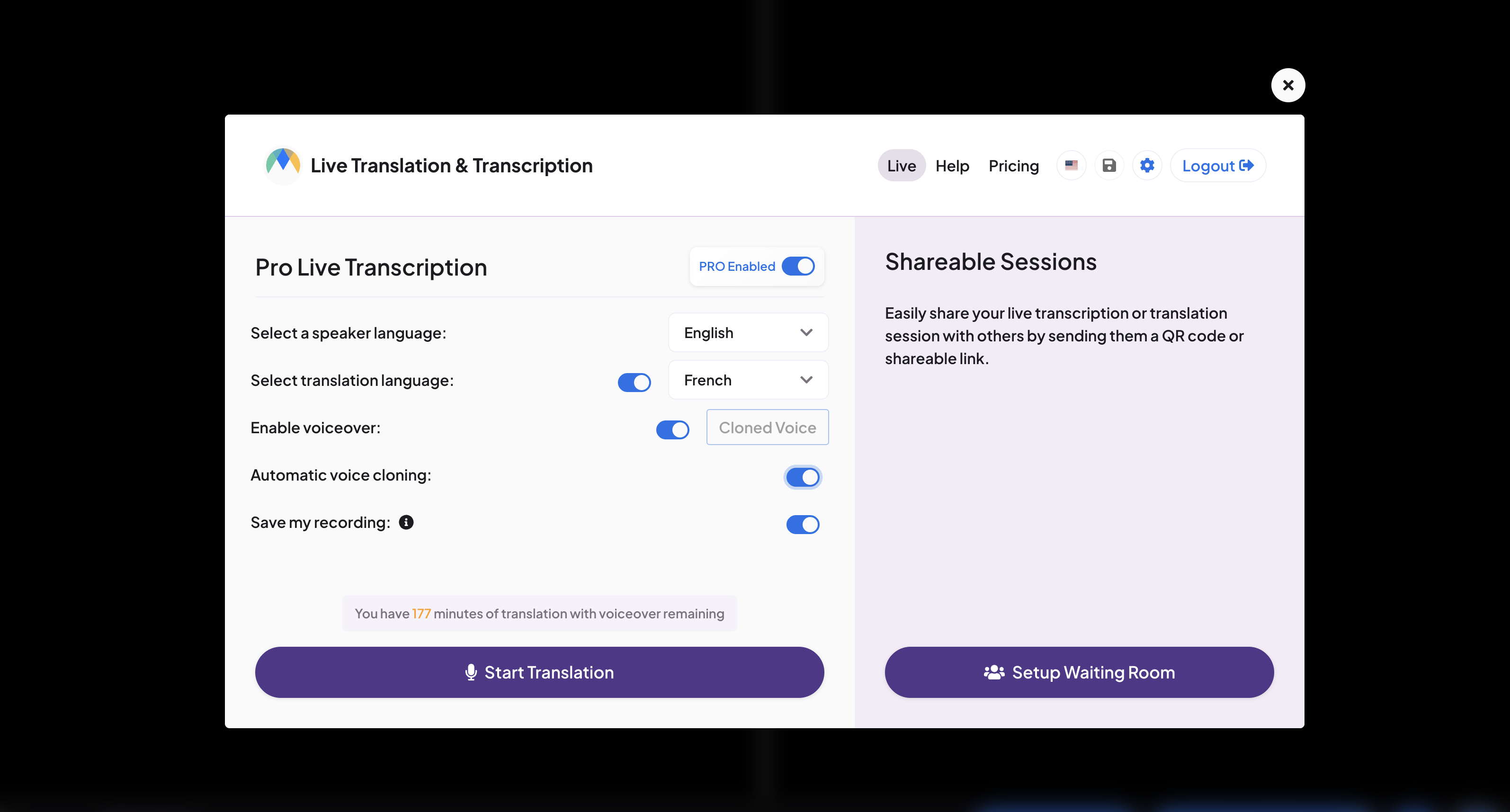
2. Google Translate
Best for: everyday users who want an all-rounder app for travel, text, and voice.
Google Translate remains the most accessible translation tool. It supports over 100 languages, including French, with live conversation mode, camera translation for menus and signs, and offline packs for travelers.
Pros
- Huge feature set (text, voice, camera, handwriting)
- Offline functionality
- Integration with other Google services (Docs, Chrome, etc.)
Cons
- Can sound robotic with idioms and nuanced phrases
- Accuracy may fluctuate depending on the context
Pricing: Free.
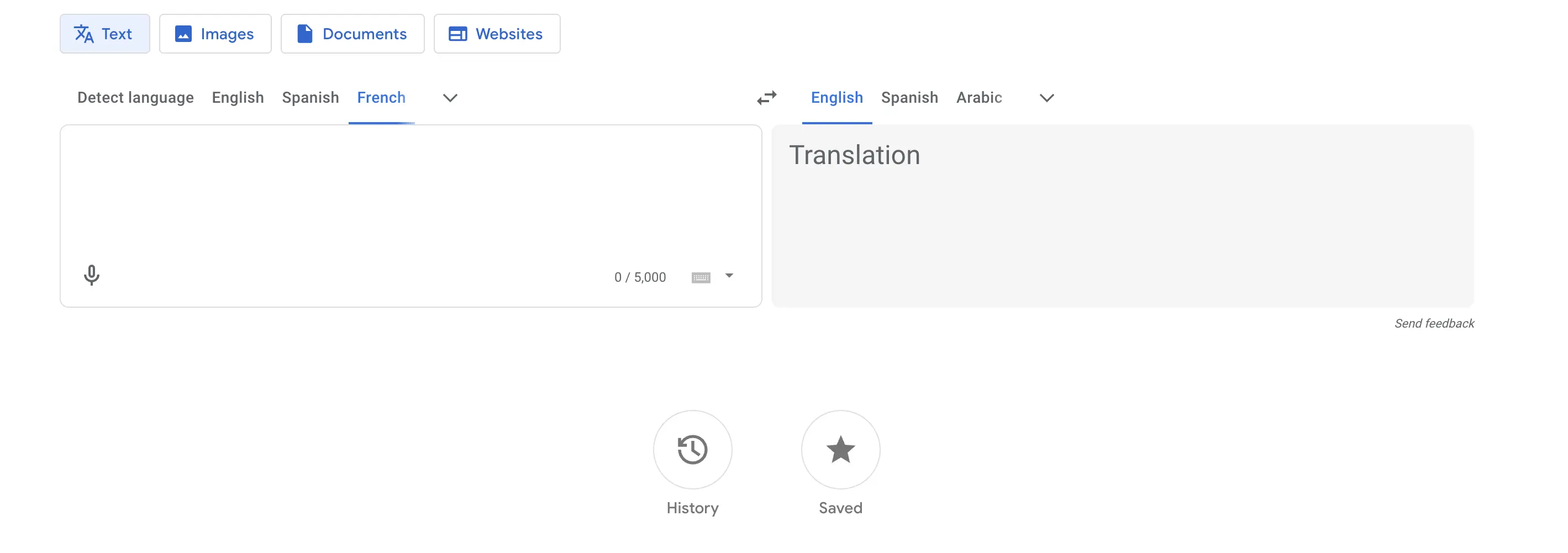
3. DeepL
Best for: professionals and businesses needing highly accurate and natural written French translations.
As one of the best translation apps, DeepL's AI engine produces fluent, context-aware French translations that often surpass other major translators. It's perfect for translating documents and business communications, and the glossary feature helps maintain tone and brand style.
Pros
- Exceptional accuracy and fluency
- Glossary and tone settings for consistent translations
- Business-ready API and document uploads
Cons
- Limited voice or camera features
- Some features locked behind the Pro plan
Pricing: Free plan available; Individual plan starts at $8.74 per month and is free for 30 days. See more on pricing.
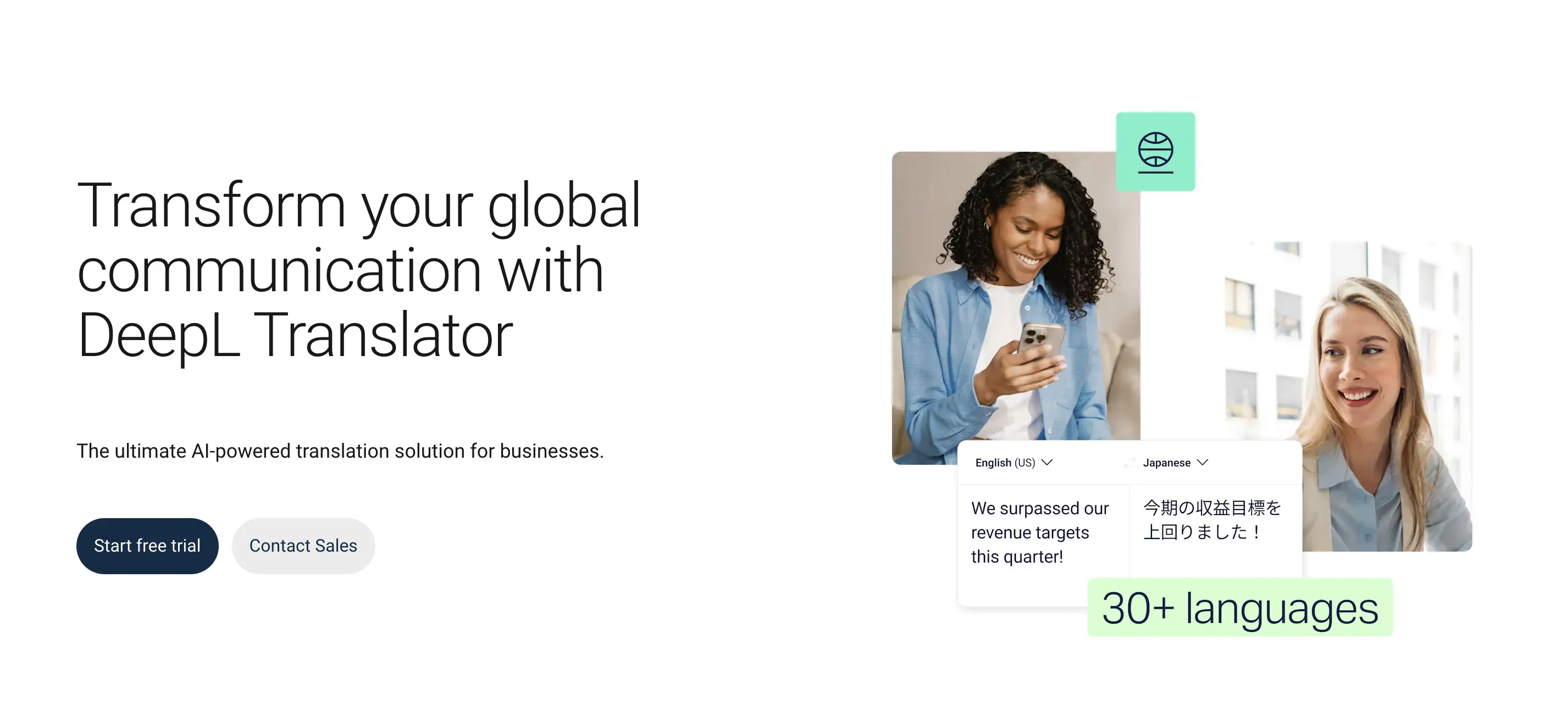
4. Reverso Context
Best for: language learners and writers who need accurate, contextual French examples.
Reverso doesn't just translate; it also teaches. It pulls real-world sentence examples from news, books, and movies, helping users understand idiomatic usage, tone, and context. It also includes flashcards and conjugation tools for those improving their French skills.
Pros
- Real-world sentence examples
- Integrates learning tools such as flashcards and grammar tips
- Available across web and mobile
Cons
- Slower for quick translations
- Offline mode and advanced features require Premium
Pricing: Free version available; Premium starts at about $6.49/month. See more on pricing.
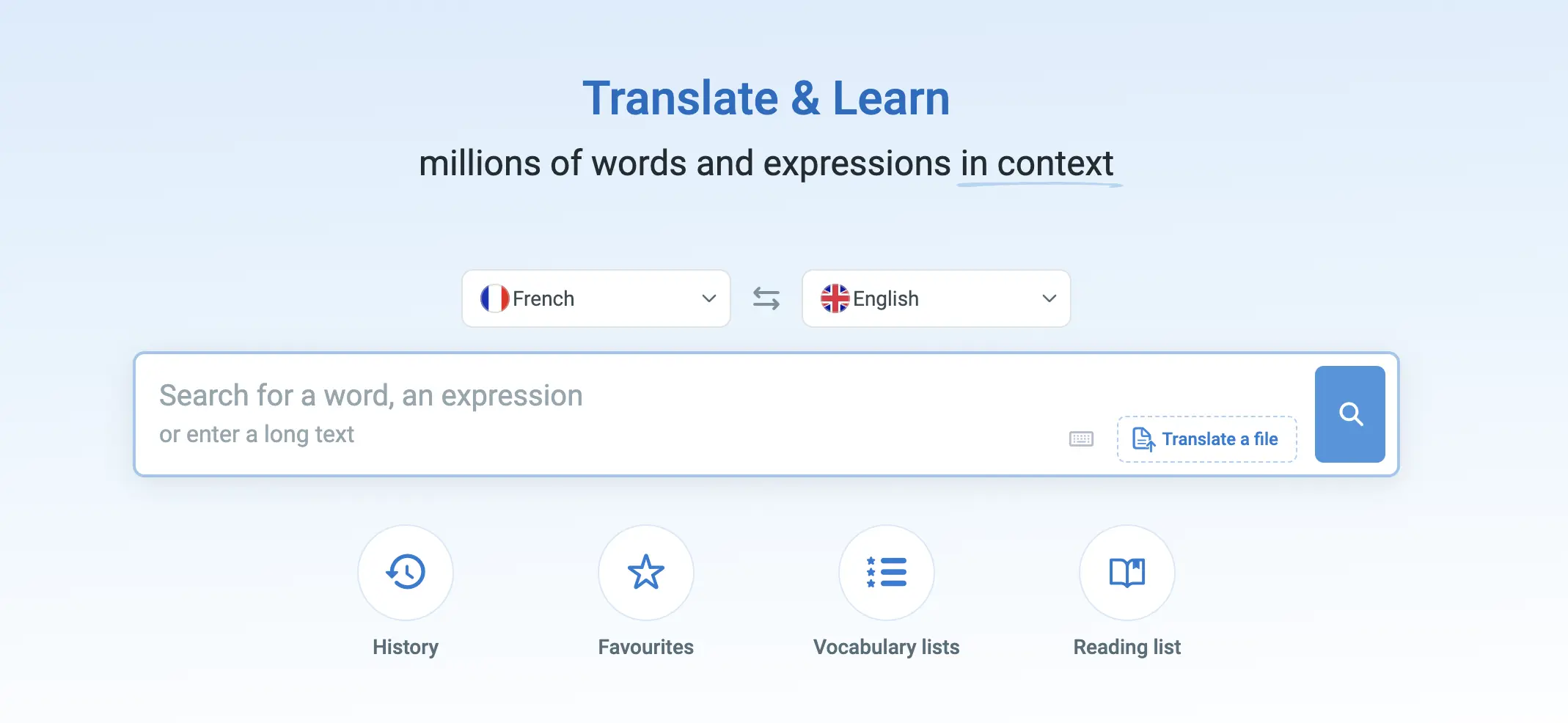
5. Yandex Translate
Best for: users seeking a feature-rich alternative to Google Translate with offline capabilities.
Yandex Translate, developed by Russia's largest tech company, offers a comprehensive translation experience. It supports 100+ languages including French, with offline mode, camera translation, and voice input. The app delivers a clean, responsive interface that rivals the major players.
Pros
- Voice, text, and camera translation modes
- Responsive interface with offline functionality
- Predictive typing and auto-language detection
Cons
- Slightly less natural phrasing compared to DeepL or Google Translate
- Smaller user community and fewer updates
Pricing: Free.

6. Microsoft Translator
Best for: teams and professionals managing multilingual meetings or classrooms.
Microsoft Translator is designed for collaboration. It enables multi-user conversation sessions with real-time subtitles, perfect for meetings, lectures, or events. It also integrates with Microsoft Teams and Office products for enterprise use.
Pros
- Multi-person live conversation mode
- Offline mode with downloadable language packs
- Seamless integration with Microsoft 365 and Teams
Cons
- Interface can feel corporate and less intuitive
- Occasional delay in group mode translations
Pricing: Free; enterprise features available through Microsoft 365 subscriptions.
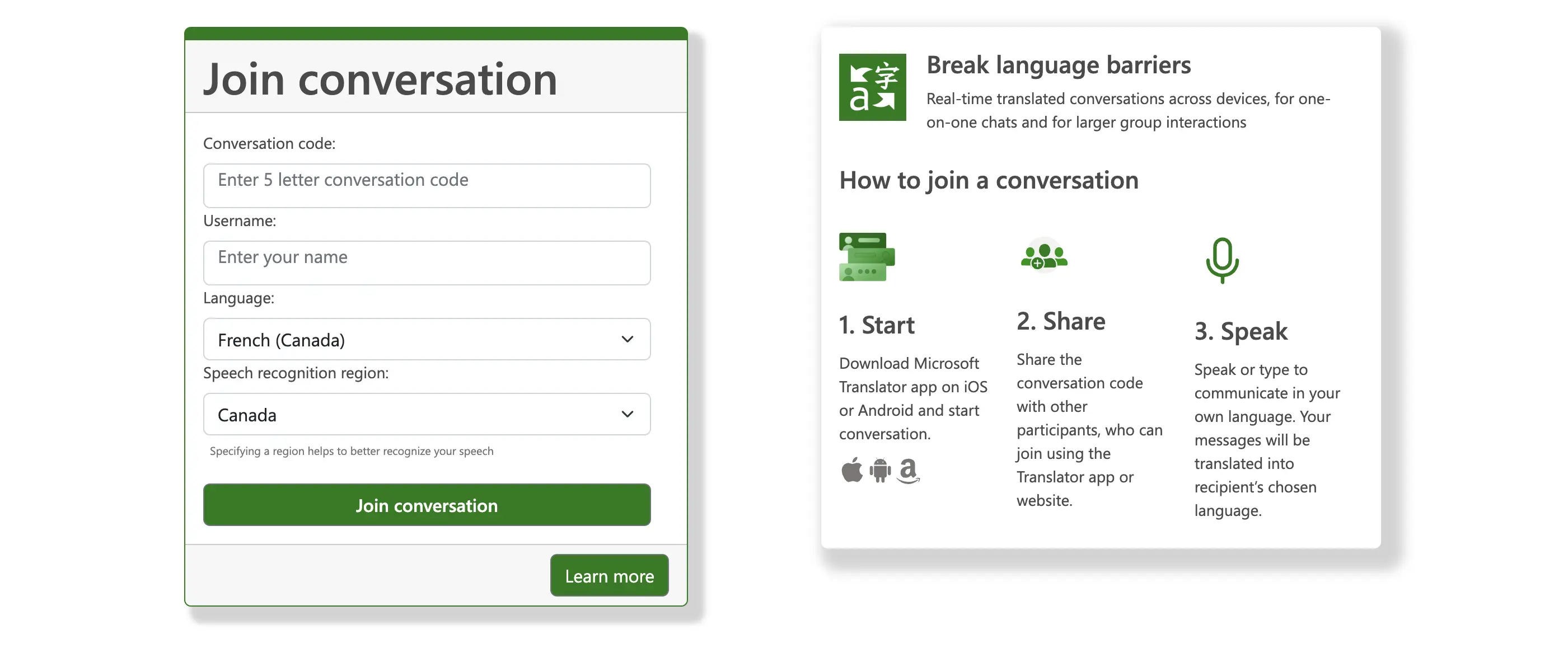
7. iTranslate
Best for: travelers and casual users seeking quick text, voice, or camera translations.
iTranslate offers a clean interface for translating text, speech, and even camera images. Offline translation packs make it handy for traveling in France or Francophone regions, while the built-in dictionary and verb conjugations help learners.
Pros
- Simple, user-friendly design
- Offline mode for travel without internet connection
- Dictionary and conjugation tools included
Cons
- Many key features locked behind paywall (camera, offline, voice)
- Translation nuance not as refined as DeepL
Pricing: Free version available; iTranslate PRO starts at $7.99 per month.
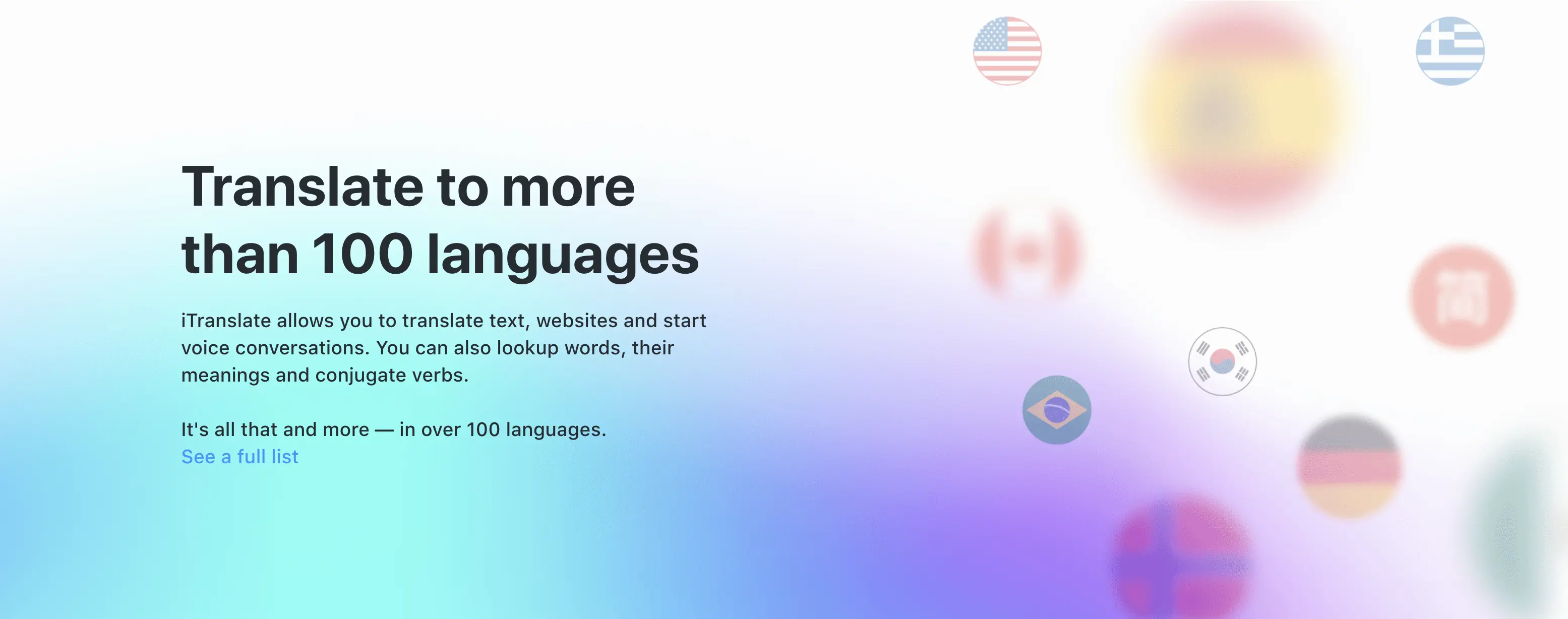
8. Naver Papago
Best for: on-the-go mobile users who want fast, accurate translations with images and conversations.
Papago, developed by Naver (often called “Korea’s Google”), excels at smooth mobile performance. It offers real-time conversation and image translation with a focus on accuracy for daily phrases, French included.
Pros
- Fast and intuitive mobile-first design
- Excellent camera/image translation for signs and menus
- Real-time voice conversation mode
Cons
- Smaller language selection than Google Translate
- No extended business or team features
Pricing: Free.
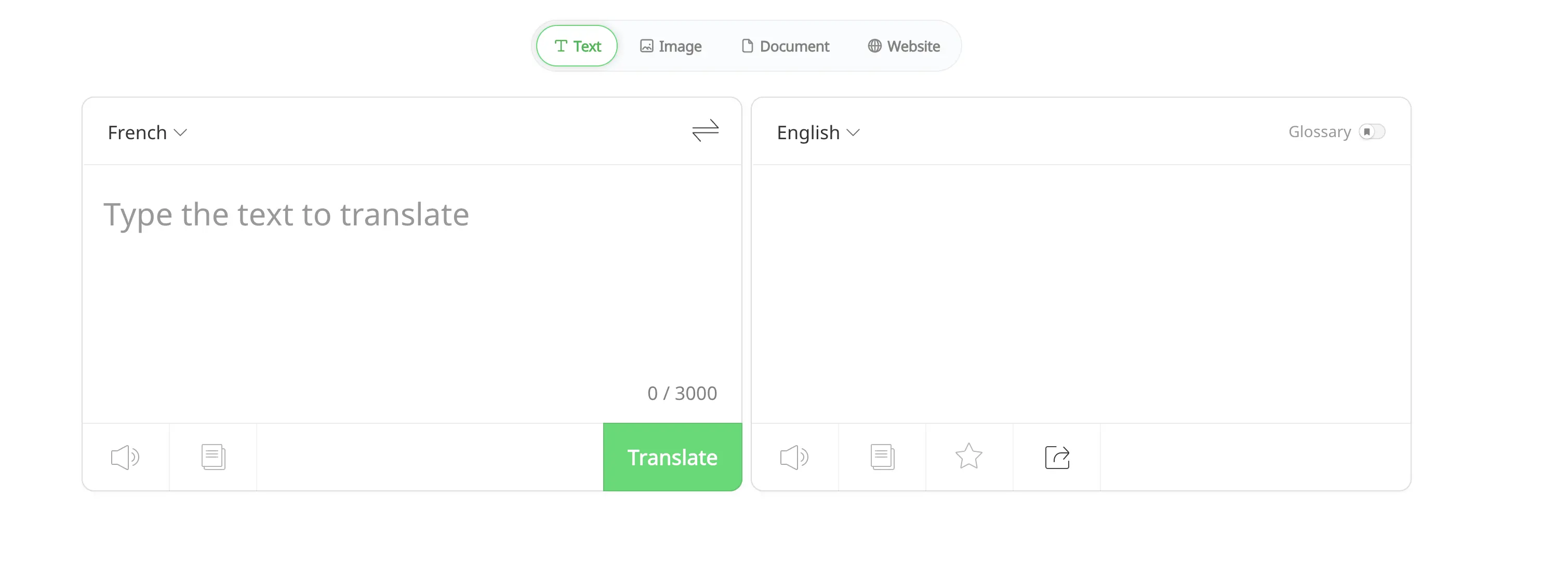
9. Linguee
Best for: anyone who wants a trusted bilingual dictionary and example-based reference.
Linguee is a must-have companion app for French learners and translators. It offers high-quality dictionary entries combined with real-world usage examples from websites and documents, and it works fully offline.
Pros
- Real-world usage examples from authentic sources
- Clean, ad-free interface
- Curated, human-checked translations
Cons
- Not a full translator (focused on words and phrases only)
- Examples can sometimes feel overly technical or formal
Pricing: Free.
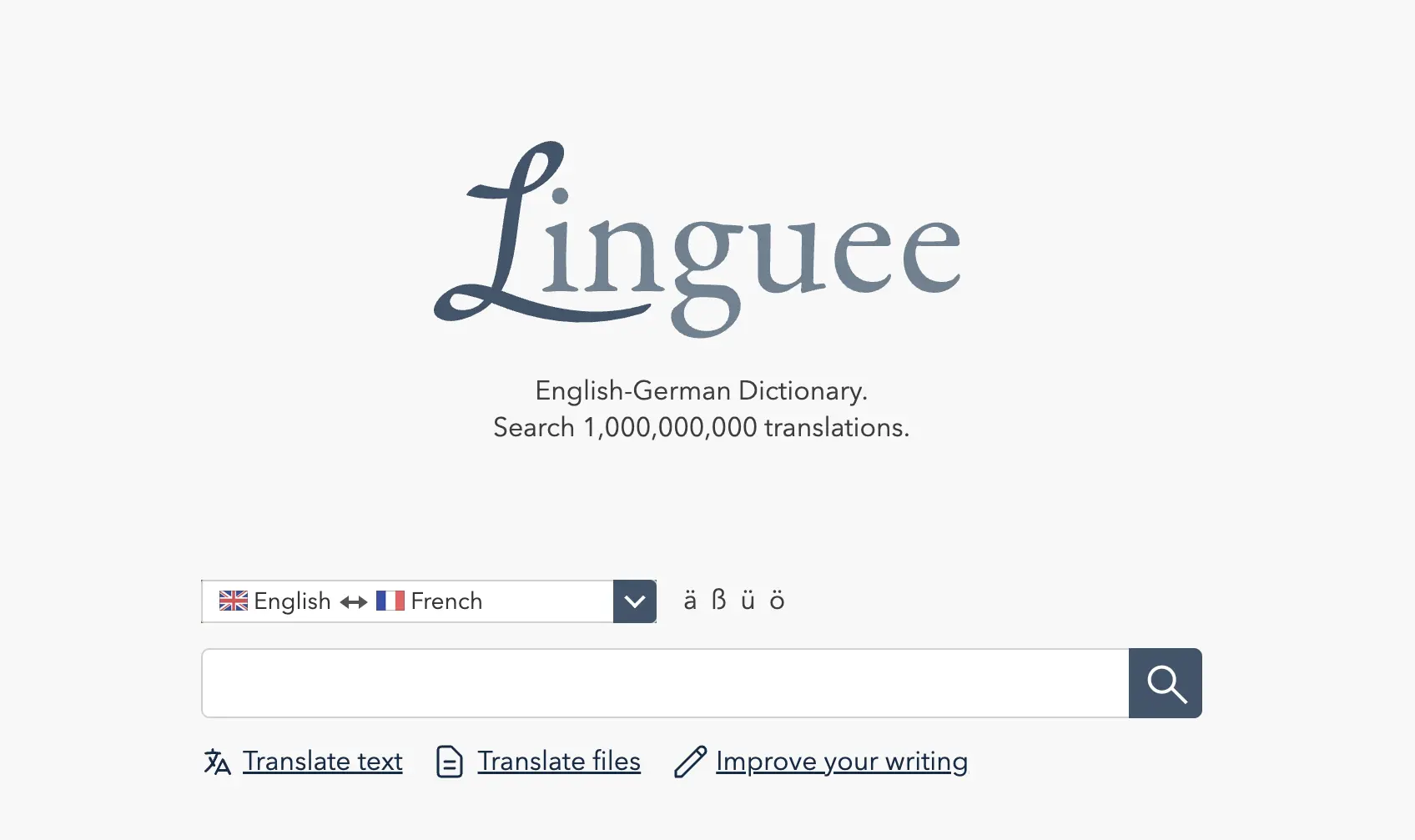
10. Vocre
Best for: casual users needing fast, hands-free speech translation.
Vocre is a straightforward voice translation app focused on instant communication. It supports 59 languages including French, with automatic language detection and a simple tap-to-translate interface. Perfect for quick conversations at cafés, shops, or casual encounters while traveling.
Pros
- Designed for fast speech translation
- Offline functionality available
- Minimal setup, easy to use
Cons
- Lacks text and document translation
- Limited additional features compared to competitors
Pricing: Free version available; Pro version is $8.99.
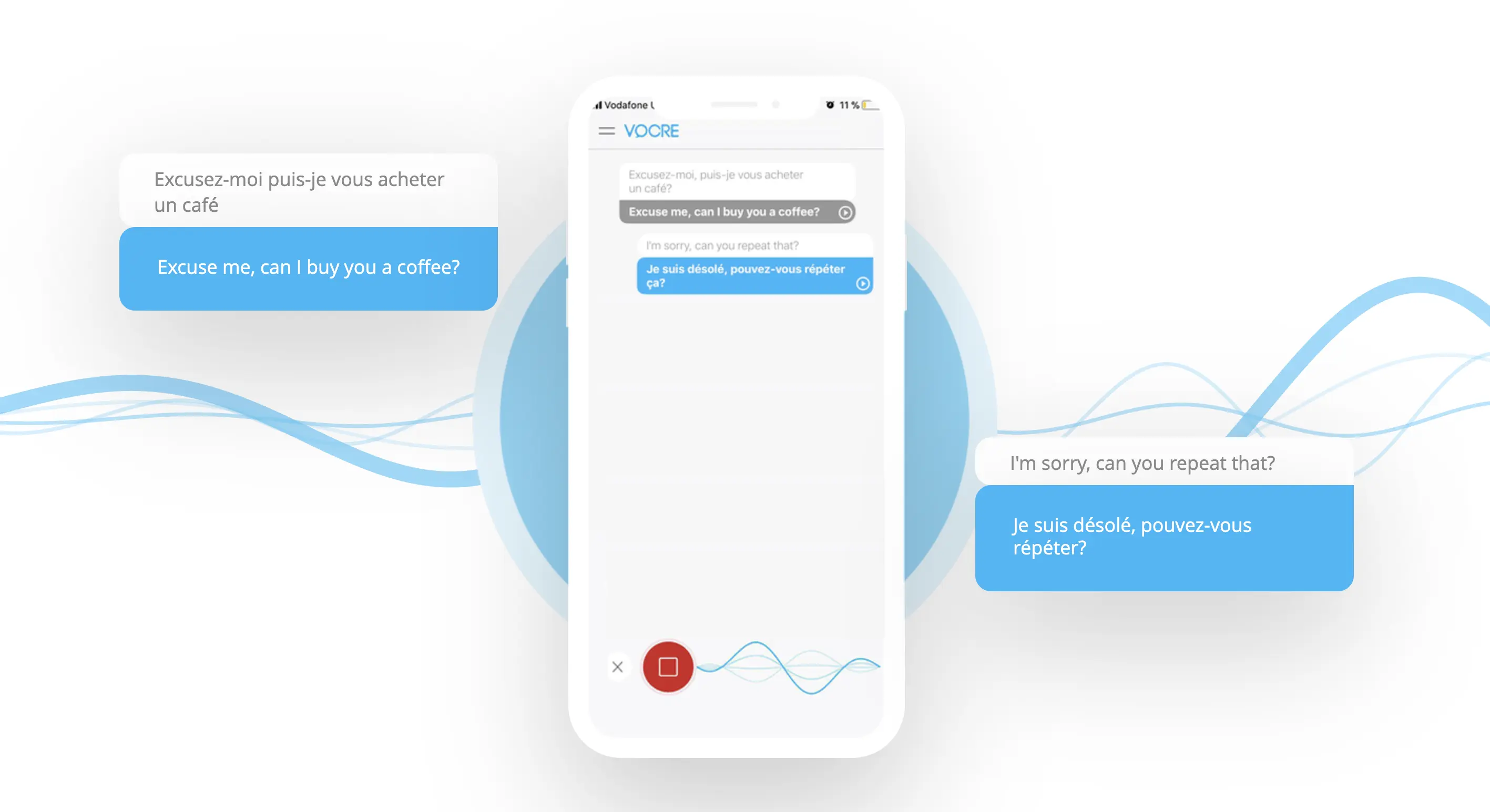
How to Choose the Right French Translator App for You
With so many French translation apps available, finding the right one depends on your specific needs and usage patterns. Consider these key factors to make the best choice for your situation.
Think About Your Main Purpose
Are you translating meetings in real time, having casual conversations while traveling, or learning French? Apps are typically designed with specific goals in mind, so understanding your primary purpose helps ensure you don’t end up with features you’ll never use.
Weigh Accuracy Against Convenience
Not all translation apps balance speed and precision the same way. Some tools are built for instant results, while others prioritize linguistic accuracy and contextual understanding. If you frequently translate nuanced or professional content, prioritize precision; if you just need quick everyday help, a simpler, faster tool may suit you better.
Assess Ease of Use
A simple and intuitive interface can make a huge difference in your overall experience. Look for apps with clean layouts, responsive design, and minimal steps to perform basic translations. The best tools let you focus on the conversation or task, not on navigating menus.

Evaluate the Extra Features
Modern translator apps often come with additional tools: voice input, camera translation, pronunciation guides, or even built-in learning exercises. While these can enhance your experience, not all extras are essential. Focus on the features that genuinely align with your workflow or learning goals rather than getting distracted by novelty options.
Consider Pricing and Value
Most translation apps offer a free tier, but premium plans usually unlock more advanced features, better accuracy, or offline use. Think about how often you’ll rely on the app and whether paying for a subscription will actually improve your productivity or communication.
Once you've weighed these factors, it’ll be much easier to identify the best French translation apps that align with your goals and lifestyle.
💡 Tip: If you're an iPhone user, you might also be interested in the Apple AirPods live translation feature, which supports French and delivers real-time translations directly in your ears.
How to Use French Translation Apps: Best Practices
Whether you're chatting, traveling, or working professionally, a few simple habits and smart techniques can help you get the most out of every translation. Here are some practical tips to ensure your translations are accurate, natural, and effective:
- Speak or type clearly. Use steady, natural speech and minimize background noise so the app can accurately capture your voice.
- Save useful phrases. Keep a list of frequently used translations to access them quickly and reinforce learning.
- Review translations in context. Always double-check if the meaning fits the situation, especially in formal or professional settings.
- Be aware of cultural context and localization. French varies across regions, so differences in spelling, idioms, and tone can shift meaning between France, Canada, and other Francophone areas.
- Avoid overusing slang or idioms. Many English idioms don’t translate directly into French. Opt for clear, literal wording when precision matters.
- Use offline mode when traveling. Download French language packs before your trip so you can translate signs, menus, or conversations without needing Wi-Fi or mobile data.
- Treat the app as a learning partner. Don’t just copy results; study how sentences are structured and words are gendered. Over time, you’ll rely less on translation tools and build more natural fluency.

Conclusion
From real-time voice translators to context-aware text tools, the range of French translation apps available today covers every possible need. We've covered the top options for different situations. Ultimately, the best app for you depends on how and where you plan to use it:
🎙️ Live translation: Maestra and Microsoft Translator for meetings and events.
✍️ Professional use: DeepL for accuracy; Reverso Context for context and tone.
🌍 Travel and daily use: Google Translate, iTranslate, Papago, and Yandex Translate for quick, on-the-go translations.
📚 Learning and reference: Reverso Context and Linguee for examples and grammar support.
💬 Quick voice translation: Vocre for instant, conversational speech translation.
Whichever app you choose, you’ll unlock a faster, smarter, and more natural way to communicate in French without missing a word.
Frequently Asked Questions
What is the best free online French translator right now?
DeepL offers some of the most accurate and natural French translations available, though its full version requires a paid plan. The free version works well for short text but has limits on usage and features. For completely free translations, Google Translate remains a strong alternative.
Is there an app that can translate French speech in real time?
Yes, Maestra's live French voice translator can translate French speech in real time. You simply speak, and it instantly translates your voice into the target language with both spoken audio and on-screen captions. With support for French and 125+ other languages, it’s built for instant, smooth communication.
Which app is best for live French voice translation?
Maestra is one of the best apps for live French voice translation. It listens to your voice and instantly speaks the translation while showing caption on screen at the same time. You can use it during events, meetings, or streams to make multilingual communication effortless.
Which French translator supports both voice and text simultaneously?
Google Translate supports both text and voice input, letting you type or speak in French and hear the translation instantly. The app can display the written translation and play it aloud for natural conversation flow. iTranslate and Microsoft Translator also offer similar dual-input features.
How do I translate subtitles or videos into French?
You can use Maestra’s AI subtitle translator or AI video translator to translate subtitles or videos into French. The video translator includes AI-generated voices, voice cloning, and precise lip syncing for a natural viewing experience. Meanwhile, subtitles are fully customizable, and can be embedded in the video or exported as separate files.
What is the best French translation app for iPhone?
For iPhone users, iTranslate and Google Translate are among the best options. Both apps are optimized for iOS, offering smooth performance, and voice or camera translation. iTranslate PRO adds premium features like offline mode and conversation translation, making it perfect for travel or on-the-go use.
What is the best French translation app for Android?
If you’re on Android, Google Translate and Naver Papago deliver one of the most reliable and user-friendly experiences. Google Translate supports instant text, voice, and camera translations, and offers offline French translation, a big plus for travelers. Papago excels in quick conversational and image-based translations, making both apps ideal for everyday French communication.
Can I use ChatGPT to translate French to English?
Absolutely. It works through text input, so you can simply type or paste your French text to get an instant English translation. You can even ask it to adjust the tone to be more formal, casual, or creative.
